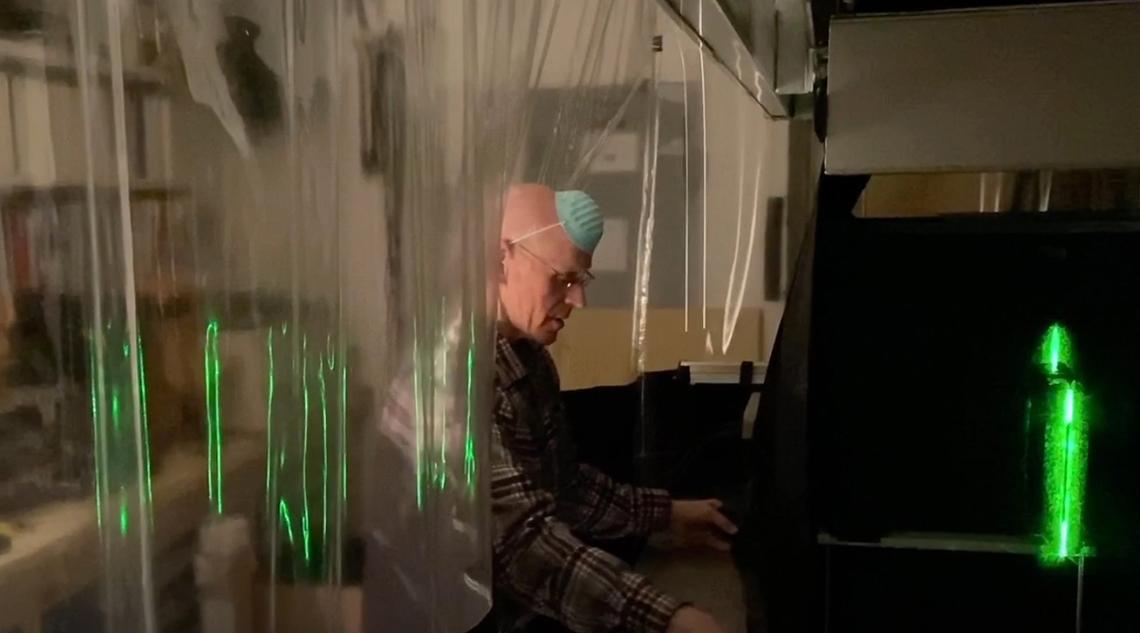NIDDK Research Shows Importance of Masks

As Covid-19 began spreading in the United States, scientists in NIDDK’s Laboratory of Chemical Physics (LCP) were already thinking about how to pivot their research to help end the pandemic. As the NIH campus emptied out, the LCP team, led by Drs. Adriaan Bax and Philip Anfinrud, began studying how people might be transmitting the virus through speech.
Their research in the weeks to follow found that normal talking disperses many saliva droplets that can linger in the air, and that wearing a cloth mask helps dramatically in blocking these droplets from being released.
It all began with a conversation between Bax and his wife. Bax had been in contact with one of his former postdocs currently in a faculty position in Wuhan, China, and he was intrigued by why Covid-19 was spreading so aggressively there. He and his wife, who is a linguist, chatted about how people spit when they talk and how some words cause more saliva spray than others. Bax wondered if speaking could be a coronavirus pathway, particularly among asymptomatic people, for spreading harmful germs.
“Everyone was talking about washing your hands and coughing into your elbow to cover your mouth, which are important, but nobody was mentioning speaking,” said Bax. “Although older studies have indicated that talking generates as much or more droplets than coughing or sneezing, visualizing this with newer technology was needed.”
The challenge was that, unlike droplets released by sneezing and coughing, speech droplets are too small to detect without extremely sensitive scientific equipment. Bax turned to Anfinrud, who runs a laser lab normally used to study protein structural dynamics.
“Given our laser-related research backgrounds, it wasn’t much of a stretch to repurpose existing equipment to visualize speech droplets,” said Anfinrud.

Anfinrud painted the inside of a cardboard box black, cut slits in the sides and directed an intense laser light sheet through the slits. His idea was to speak into the box so that the speech particles would generate flashes of light as they passed through the light sheet. In just a few hours on a Saturday morning, he had an apparatus up and running. He called in Bax and Dr. Valentyn Stadnytskyi, a postdoctoral fellow in his lab with expertise in lasers and optics, and the scientists spent much of that weekend recording video clips with a smart phone and interpreting the data they recorded.
The video clips showed that saying simple phrases can generate thousands of potentially infectious speech droplets. Furthermore, wearing a homemade cloth mask blocked 99 percent of the droplet particles from being released.
The researchers, along with Bax’s daughter Christina, a medical student at the University of Pennsylvania and an NIDDK special volunteer, drafted the findings in a letter sent to the editor of the New England Journal of Medicine on Mar. 30 and also shared these findings with the CDC.
“We saw this as a call to action and took every step to get this to people quickly,” said Bax. “Our goal was not to get another publication; it was to use our data to help implement changes that we thought could help save thousands of lives.”

The letter was published on Apr. 15, shortly after the CDC began recommending the use of face coverings. But the researchers’ work was far from over. Their next project, already underway, aimed to quantitatively characterize the number and size of speech-generated droplets and determine how long these droplets can linger in the air.
The results, again captured on video, showed that loud speech produced several thousand droplets per second, and in a confined space of stagnant air, the droplets remained airborne for 8 to 14 minutes. The study, published in the Proceedings of the National Academy of Sciences on May 13, suggests that normal speaking in enclosed environments can carry a substantial risk of spreading infectious particles, if the speaker carries a virus such as SARS-CoV-2.
“How far might speech droplets travel before reaching the ground? Air convection and ventilation are factors, but anyone who has been in a room when someone lit up a cigarette may recall how quickly smoke permeates the space,” said Anfinrud. “Theoretically, a cell infected by just one SARS-CoV-2 virus particle can lead to a full-blown case of Covid-19. However, our findings suggest that if everyone wore a simple face covering, we could stop most speech particles at their source.”
NIDDK director Dr. Griffin Rodgers concurred. “The researchers showed in a visually compelling way how saliva droplets—which are normally invisible—could be driving transmission of Covid-19,” he said. “We hope these results show people that taking simple measures, such as wearing masks and practicing physical distancing, can help keep themselves and those around them healthy, especially in this crucial period before we have a vaccine.”
